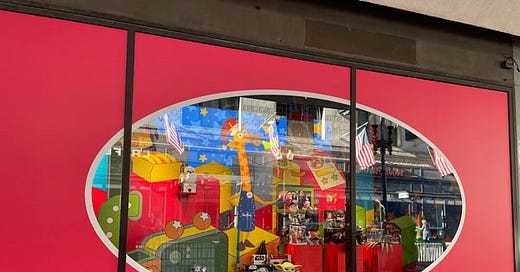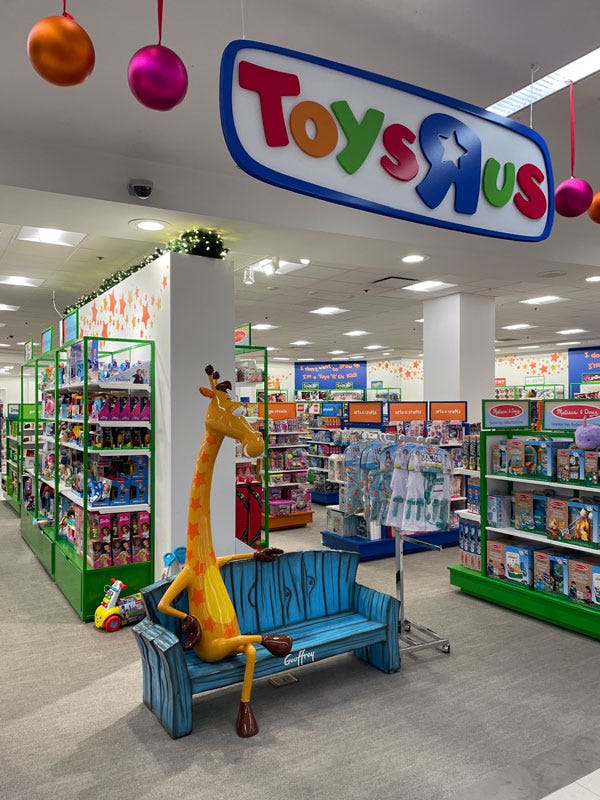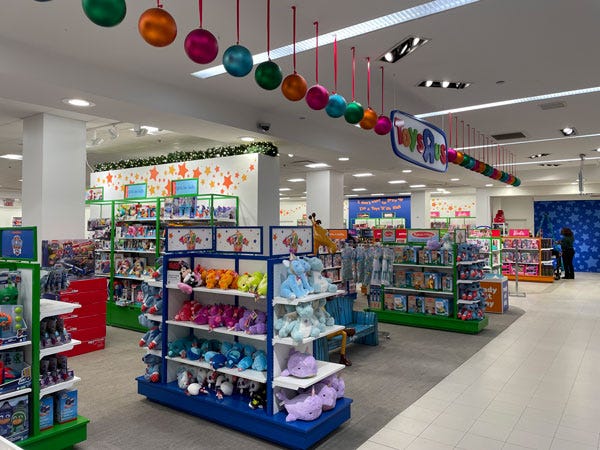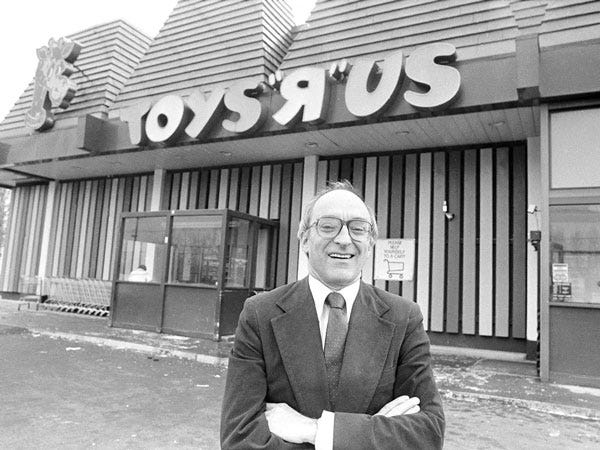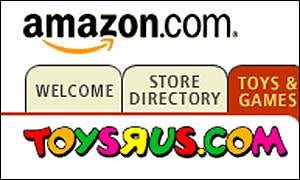The Many Incarnations of Toys R Us
How the toy retailer has spent more than two decades lending out its name to other ventures and has never quite died.
Welcome to the Quarantine Creatives newsletter, a companion to my podcast of the same name, which explores creativity, art, and big ideas as we continue to live through this pandemic.
If you like what you’re reading, you can subscribe for free to have this newsletter delivered to your inbox on Wednesdays and Sundays:
Last week, I wrote about discovering the history of Boston by reading two historic plaques that happen to be attached to the side of a Macy’s store in Downtown Boston.
This week, I am once again inspired by that same Macy’s store, although with Thanksgiving and Black Friday approaching, I instead want to look at a newer element of that store. Let’s start with the window displays.
Here’s what the large windows that face Summer Street currently look like at Macy’s in Boston:
This particular Macy’s, like many others around the country, is home to a resurrected version of Toys R Us, and Macy’s has gone all out to advertise this new addition. It’s what’s referred to as a “store within a store,” where a particular department in a larger store provides a separate branded experience, but still shares the staffing and other infrastructure of the main store.
At the Boston Macy’s, Toys R Us is located on the basement level, along with kids’ clothing and furniture. The department has distinct signage and branding that feel familiar. There is even a photo opportunity with Geoffrey the Giraffe, the Toys R Us mascot.
If you’ve been a longtime reader, you may know that Toys R Us is a special brand for me. I began working there as a teenage cashier and ended up spending five years with the company, working in six stores across three states through my high school and college years.
Of course, when I was employed there, Toys R Us was a big box retailer, not a section of a department store. At one time, Toys R Us operated more than 800 stores in the United States, though by the time the company filed for bankruptcy protection and subsequently closed all U.S. stores in 2018, there were around 700 stores left.
The strange thing about visiting this “store within a store” incarnation of Toys R Us was that it felt weirdly hollow. Once you get past the decorations, there’s not a lot of there there.
I walked around the department in Boston recently, hoping to be reacquainted with memories from my childhood, my teenage years as an associate, or the early years of my kids’ lives when Toys R Us was still a shopping destination. Instead, I saw all of the same items that line the toy shelves at Target, Wal-Mart, or Amazon: Barbie, Hot Wheels, Lego, Disney, Melissa and Doug, and Marvel.
Aside from a few reusable bags with the Toys R Us logo, there was no distinct Toys R Us merchandise. I was hoping to maybe see a Geoffrey plush toy or figurine or an “I’m a Toys R Us Kid” t-shirt. Since those items were absent, it literally felt like the toy department anywhere.
This makes the decision to add Toys R Us “stores” to Macy’s a curious one. Had Macy’s wanted to sell toys, they could have easily dedicated floor space to a toy department. Why call it Toys R Us? It turns out, the Toys R Us store within a store concept is nothing new, and Toys R Us has been trying to extend their brand beyond the big box for decades.
Today, I wanted to explore the history of Toys R Us, looking at how its name and the names of other toy stores have been used over the years. The story of Toys R Us is the story of retail over the last half century in the U.S.
Toys R Us was founded in 1948 by Charles Lazarus as a children’s furniture store in Washington D.C. called Children’s Bargain Town. His obituary in The Washington Post explains his shift from selling changing tables to selling toys:
“Parents soon began asking Lazarus where they could buy toys — so he stocked them. When a parent came back to buy another toy after the first one broke, Lazarus had an epiphany: He might only sell one crib to a family, but toy customers would keep them coming back.”
The company would adopt the name Toys R Us in 1957 and began expanding into the growing suburbs. The move from urban core to suburban strip was happening to many other businesses of the era, and Lazarus took inspiration from a style of retail that was surging in the Post War era:
“What we are is a supermarket for toys,” founder Charles Lazarus once told The Post. “We don’t have a competitor in variety. There is none.”
This notion of Toys R Us as a supermarket is a connection I hadn’t made, but I think it’s quite apt. According to Chester H. Liebs, author of Main Street to Miracle Mile, supermarkets began to appear in the 1930s but became standardized by the 1950s. The hallmarks of a supermarket are all present at Toys R Us too:
“On the inside, vertical wall shelves were considered obsolete. As their replacement, banks of shelves called ‘gondolas’- which are long and narrow and can carry a full payload the way a Venetian gondola or gondola railroad car can- came into vogue. So did gondola end displays- those familiar piles of marked-down merchandise that are still found at the ends of supermarket aisles…
During this period, almost every aspect of creating visual appeal was evaluated for its effectiveness. Manufacturers even got into the act. Realizing that supermarket shelves represented millions of feet of free exhibition space for their products, they became increasingly concerned about the way that consumers reacted to the sight of their merchandise. Companies redesigned their labels and redesigned their packaging for maximum appeal.”
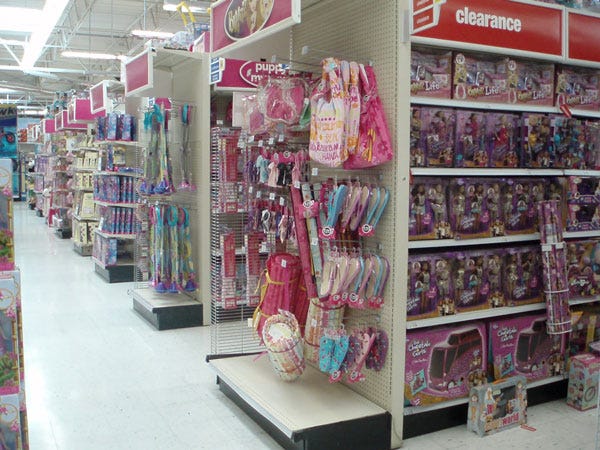
The Toys R Us stores of my childhood featured long aisles laid out on a grid and navigated by a shopping cart. When Liebs describes the supermarket, his analogy extends to a Toys R Us store, but also the suburban landscape at large:
“Interestingly, by developing this format, food merchants had inadvertently created within the supermarket a microcosm of the new shopping areas that were rapidly spreading across postwar America- the suburban strips. The similarities between guiding a cart down the aisles of a nearby Acme or Grand Union and driving a car along the local Miracle Mile are striking. Like strips, supermarkets are traversed by highways. Each shopper maneuvers a vehicle down the interior streets, being careful not to collide with other traffic, while scanning the package labels that line the aisles like signs along the highway. Yet where the order in which signs appear along the roadside strip is often random (depending on when each wayside merchant purchased a piece of frontage land), the procession of visual events in the supermarket is preplanned and totally contrived. It is a masterwork of psychological zoning enacted in miniature, begun by pioneers such as Clarence Saunders [founder of Piggly Wiggly], and still in practice to this very day.”
When I started working there in 2000, Toys R Us was already beginning to stumble. Wal-Mart had surpassed Toys R Us as the top toy retailer in the U.S. The competitive side of me wanted to somehow prove to our customers that a specialty toy store was better, but my store manager had a realistic view of the situation. His take was that Wal-Mart would prevail because “everybody needs toilet paper.” His implication was that people would shop at Wal-Mart for their necessities, but they wouldn’t make a dedicated trip just to go to a toy store. He was right.
Ironically, even if the big box stores don’t hold the same appeal now as they did in years past, the name Toys R Us was and still is a powerful brand. The usage of the name and logo outside of a big box format go back at least two decades.
In 2000, Toys R Us signed a 10 year deal with Amazon to manage a branded storefront of toy and baby products within the online retailer. Toys R Us’s online inventory and ordering was hosted on Amazon’s homepage under the agreement.
This was in the era before Amazon sold everything under the sun and shipped it within a day. At the turn of the twenty-first century, Amazon’s primary source of revenue was selling media like books and CDs. Expanding into toys was new territory and partnering with Toys R Us was a way to accelerate that growth.
The deal went south quickly, with Toys R Us claiming that Amazon did not stick to an exclusivity agreement, and allowed other companies to sell toys on the site. Amazon claimed that Toys R Us did not provide the promised inventory. This tidbit from The Wall Street Journal looking back at negotiations between Toys R Us CEO John Eyler and Amazon CEO Jeff Bezos prior to signing the deal gives a glimpse into where Amazon was headed:
“To break the impasse, John Eyler, Toys ‘R’ Us's chief executive, flew to Seattle and met Amazon Chief Executive Jeff Bezos at his headquarters on June 28, 2000. Mr. Bezos explained that ‘someone ought to be able to find everything’ in the online toy store, testified Mr. Eyler. Mr. Eyler explained that toy sellers cannot carry a limitless product line and be profitable.” (emphasis added)
In 2001, Toys R Us signed a licensing deal with mid-Atlantic grocery chain Giant for a store within a store concept that would carry Toys R Us branding and products within the supermarket. In 2002, a similar program was tested with Albertson’s, which operated both grocery stores and Jewel-Osco pharmacies. At the time, the partnerships were considered a possible look at the future, according to an article from Supermarket News in 2001:
"It's going to be the wave of the future," [Kurt Barnard of Barnard's Retail Consulting Group] said. "Chances are [the Giant stores] will make more money on toys than anything else they had in the section."
It’s unclear when the partnerships with these grocery chains ended or how successful they were, but it is notable that Toys R Us began to see a value in their name outside of their traditional footprint.
The names of other toy stores also proved valuable during this era. In 1999, Toys R Us purchased specialty educational toy retailer Imaginarium, which operated 41 small format boutiques. (One of the stores that I worked at in my tenure at Toys R Us was an Imaginarium in Brookline, MA). Toys R Us continued to operate the stores until shuttering the entire chain in 2003 along with all freestanding clothing stores known as Kids R Us in a move designed to cut costs and streamline the core business.
However, Imaginarium didn’t die with the store closures. At the time of the brand’s purchase in 1999, Imaginarium became the name of the educational toy department within Toys R Us. It was a bit of a store within a store concept in fact, with Imaginarium departments being outfitted with nice wood shelves (the rest of Toys R Us was metal), blue carpeting (the rest of the store was vinyl), and was the destination for higher end toys like Lego, Thomas the Tank Engine train sets, and wooden toys from Melissa and Doug.
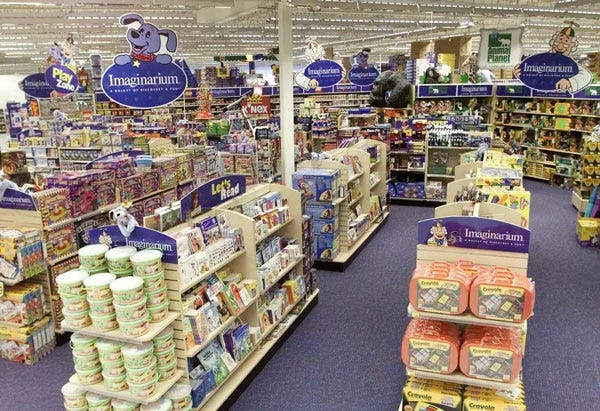
Even though it’s been almost two decades since Imaginarium was operated as a standalone store, the brand’s logo is still on display with the educational toys in the Toys R Us store at Macy’s.
In 2009, Toys R Us purchased FAO Schwarz, the high end toy store known for its boutique on Fifth Avenue. FAO Schwarz was struggling financially at the time. In addition to operating the flagship shop in New York and another in Las Vegas, at the time of the acquisition, FAO was also in the midst of creating FAO stores within a store at, where else, Macy’s. According to NBC News:
“A deal FAO Schwarz brokered with Macy's Inc. to open small locations in 685 Macy's will end in November. Only 260 of those opened and the outposts will be phased out after the deal ends.”
Toys R Us sold an extensive lineup of FAO branded toys in its stores for many years and it operated the FAO New York flagship location until shuttering it in 2015. Toys R Us eventually sold the brand in 2016.
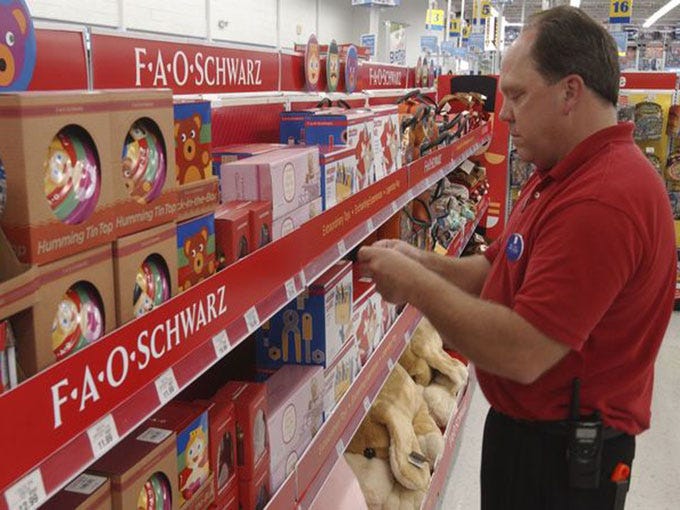
Under new ownership, FAO opened a new flagship location in New York at Rockefeller Center in 2018 and recently partnered with Target to sell FAO branded toys exclusively at the discount chain.
Toys R Us also purchased former competitor KB Toys in 2009 after KB declared bankruptcy. Unlike with Imaginarium and FAO Schwarz, no KB Toys branding was integrated into Toys R Us. KB Toys was purchased from the U.S. Trademark Office in 2016 after the name went unused by Toys R Us, and comeback of the brand was briefly promised, although it never materialized.
Toys R Us officially closed all of its U.S. stores in 2018, but almost immediately, there were attempts at reviving the name. During the holiday season in 2018, Kroger placed branded Toys R Us displays in its grocery stores, selling popular toy items on racks with Geoffrey the Giraffe.

In 2019, small format Toys R Us stores at malls in New Jersey and Texas opened, with a plan to eventually open 10 mall-based shops. This plan was scuttled because of the pandemic and the two existing mall stores closed.
In 2021, Toys R Us opened a new flagship store located in the American Dream mall in New Jersey’s Meadowlands. The store is two stories and features a slide between levels and an ice cream parlor.
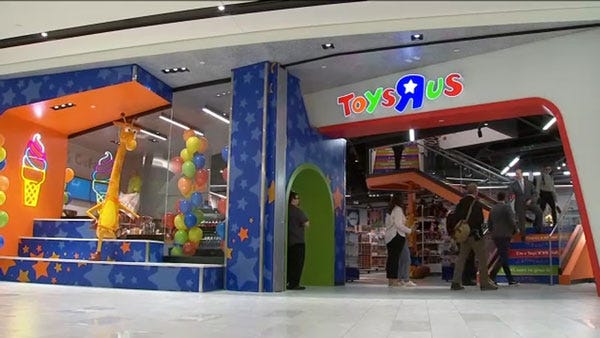
So what is Toys R Us today? Its current owners are operating an e-commerce site at toysrus.com (which briefly used Target for order fulfillment), there’s the single store in New Jersey, and their branding is being loaned to Macy’s, at least for this holiday season. That’s a far cry from the 800 or so locations it had a few years ago, but it also didn’t go the way of Blockbuster Video or Circuit City.
The brand carries lots of nostalgia for people of my generation, but that can be difficult to quantify or value. At the end of the day, the exact same merchandise is being sold at lots of other places, often at a better price.
Toys R Us was founded at the start of the baby boom. It became a household name when the nation was suburbanizing and turning to shopping malls and big box stores. It stumbled in the age of the internet and is more valuable now as a marketing tool than an actual place.
Perhaps the most fitting epilogue to this story is to look at the fate of one of my local Toys R Us stores in Nashua, New Hampshire. It is currently under renovation and is expected to open as the area’s first Amazon Fresh Market.
Toys R Us, the “kids’ supermarket” for decades, is now being renovated into an actual supermarket. And that supermarket is being operated by Amazon, the company that 20 years ago sold books and CDs online and had an ill-fated partnership with Toys R Us.
If you’re feeling nostalgic and want to get your picture with Geoffrey the Giraffe, take a trip to Macy’s. You may buy a toy while you’re there, or you may use your phone to check if it’s cheaper on Amazon and have it shipped to your house.
What are your thoughts on Toys R Us? Why does the name seem to endure even if the store has trouble succeeding? Drop a comment to share your thoughts.
Related Reading
At the Corner of Washington and Summer
If you’d like to catch up on past episodes of the Quarantine Creatives podcast, they can be found on Apple Podcasts, Spotify, or wherever you listen.
If you’ve missed past issues of this newsletter, they are available to read here.
Stay Safe!
Heath


